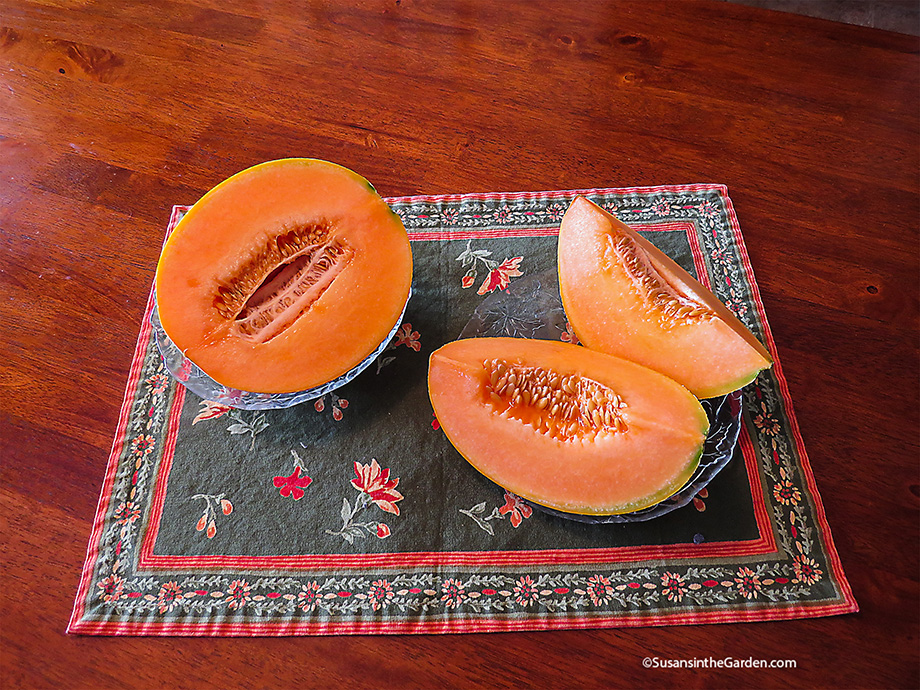How to Grow Melons

When I first learned how to grow melons many years ago, I had no idea how transformative it would be. You absolutely cannot top the sweet, succulent taste of a fully-ripened melon! They’re not hard to grow once you read through my tips below.
Latin Name: Cucumis melo
Plant Family: Cucurbit (Cucurbitaceae)
Warm-season crop
Did You Know?
Many gardeners with short growing seasons think growing melons is not even an option. I’m here to tell you that it’s very doable. Just choose some of the shorter-season cultivars and follow my techniques for getting the plants off to a great start. In addition to cantaloupe and honeydew melons, there are many wonderful specialty melons to choose from. If you have only eaten grocery store melons, wait until you taste a fully ripe, succulent melon. You will definitely want to grow melons from that moment on! (note: if you want to know how to grow watermelons, there is a separate blog post for that)
Plant Seeds or Seedlings? Direct sow seeds in the garden or start seeds indoors two weeks prior to transplanting them out in the garden.
When: After all danger of frost has passed.
Days to Germination: 7 to 10 days
Depth to Sow: 1 inch. Plant seeds with pointed end facing downward for the best germination rate.
Spacing: Plant seeds or seedlings 2 feet apart, with rows spaced 2 to 3 feet apart.
Days to Maturity: 70 to 85 days
Cultural Information:
Prepare bed prior to planting by adding bonemeal to the top 3 inches of soil. Melons grow on vining plants so give them room to ramble. Fortunately, they don’t take up quite as much room as winter squash and pumpkins do. Smaller melons can also be grown on arbors and trellises. However, be sure to provide the fruits a sling-like support due to their weight.
I used to cover the planting bed with solar mulch or red plastic tomato mulch to increase the soil temperature. However, I’ve since learned that really isn’t necessary. But it’s a good idea to cover the seeds or seedlings with floating row cover. That way, you’ll provide them with a warm, greenhouse-like environment. Remove the cover after 2 to 3 weeks, before the plants start blooming so pollinators can access them. Water the plants regularly.
Here’s a tip for gardens in USDA zone 7 and below. Once each vine has a melon the size of a baseball growing on it, trim the vine back to a few inches past the melon. The plant will focus on growing and ripening each melon, instead of continuing to bloom and grow more leaves.
Susan’s Picks: Cantaloupe: ‘Tuscan Napoli’, ‘Hale’s Best’, ‘Minnesota Midget’. Honeydew: ‘Arava’, ‘Ha Ogen’.
Potential Insect Problems: pillbugs, cutworms
When to Harvest:
Watch for the following three clues. 1) The melon stem begins separating from the vine. 2) The melon skin changes from green to yellowish. 3) Yellow jackets are attracted to the wonderful aroma so will be buzzing about.
How to Cook & Preserve:
Ripe melons don’t last a long time so eat and enjoy them as soon as you can. It’s possible to store them in the refrigerator for up to two weeks. Cantaloupes can be frozen in cubes for future smoothies, or made into preserves. Use the water-bath canning method for the latter.
My Videos About Growing Melons:
Back to Vegetable Grow Guide Chart
Copyright: Susan Mulvihill, Susan’s in the Garden, SusansintheGarden.com.

